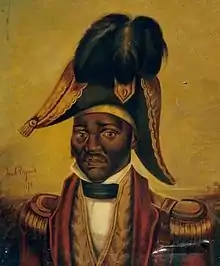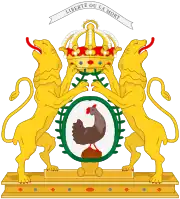First Empire of Haiti
The First Empire of Haiti,[1] officially known as the Empire of Haiti[2][3] (French: Empire d'Haïti;[4] Haitian Creole: Anpi an Ayiti),[5] was an elective monarchy in North America. Haiti was controlled by France before declaring independence on 1 January 1804. The Governor-General of Haiti, Jean-Jacques Dessalines, created the empire on 22 September 1804. After being proclaimed emperor by the Generals of the Haitian Revolution Army, he held his coronation ceremony on 6 October and took the name Jacques I. The constitution of 20 May 1805, set out the way the empire was to be governed, with the country split into six military divisions. The general of each division corresponded directly with the emperor or the general in chief appointed by the emperor. The constitution also set out the succession to the throne, with the crown being elective and the reigning emperor having the power to appoint his successor. The constitution also banned white people, with the exception of naturalised Germans and Poles, from owning property inside the empire.[6]
Empire of Haiti | |||||||||||
|---|---|---|---|---|---|---|---|---|---|---|---|
| 1804–1806 | |||||||||||
| Motto: Liberté ou la Mort! (French) "Liberty or Death!" | |||||||||||
 Territory of the Empire of Haiti (1804–1806), located on the western portion of the island of Hispaniola. To the East, on the other side of the border, is the Spanish Colony of Santo Domingo, under French control (1795–1809). The border that divides the island on the map is the border of the Treaty of Aranjuez of 1777. | |||||||||||
| Capital | Port-au-Prince | ||||||||||
| Common languages | French Haitian Creole | ||||||||||
| Religion | Roman Catholicism | ||||||||||
| Demonym(s) | Haitian | ||||||||||
| Government | Unitary elective absolute monarchy | ||||||||||
| Emperor | |||||||||||
• 1804–1806 | Jacques I | ||||||||||
| Historical era | 19th century | ||||||||||
| 1 January 1804 | |||||||||||
• Proclamation of Jean-Jacques Dessalines as Emperor Jacques I | 22 September 1804 | ||||||||||
• Assassination of Emperor Jacques I | 17 October 1806 | ||||||||||
| Currency | Haitian livre | ||||||||||
| ISO 3166 code | HT | ||||||||||
| |||||||||||
| Today part of | Haiti | ||||||||||
Jacques I was assassinated on 17 October 1806.[7] Two members of his administration, Alexandre Pétion and Henri Christophe, then assumed power, which led to a split in the country – with Pétion leading the southern Republic of Haiti and Christophe leading the northern State of Haiti (later Kingdom of Haiti).[8] Some 43 years later, on 26 August 1849, President Faustin Soulouque re-established an Empire in Haiti that lasted until 15 January 1859.[9]
History
Fearing the return of the French to the island, Dessalines built forts.

On 8 October 1804, he was crowned Emperor under the name of Jacques I of Haiti, in Cap-Haïtien under the title His Majesty Jacques I, Emperor.
At the end of February 1805, Jean-Jacques Dessalines and his troops left in two directions: one part towards the north (Dajabón-Santiago-La Vega-Saint Domingue) commanded by Henri Christophe, and another towards the south (Hinche-San Juan de la Maguana-Azua-Baní-Saint-Domingue) commanded by Dessalines himself.
On 25 February 1805, Dessalines at the head of 30,000 men captured Santiago. On the southern road, the Haitian emperor realized that the inhabitants of San Juan de la Maguana and Baní had evacuated their city to protect themselves, so he reckoned that the indigenous population did not deserve his clemency. On March 6, while approaching the capital, he ordered to set fire to the city of San Carlos on the outskirts of Santo Domingo and to begin the siege of the city. On March 25, Dessalines ordered the total extermination of the population under his control. These populations were then deported to the large cities of Haiti where they were killed in public places by being crushed (by horses or beasts of burden) and quartered.
Three days later, three frigates and two French brigantines arrived in Santo Domingo. Dessalines abandoned the siege of Santo Domingo and retreated to Haiti. In April 1805, Dessalines, Christophe and their troops razed Santiago, Moca, La Vega, Azua, San Juan de la Maguana, Baní, among others, and massacred the inhabitants who had not fled to the Central Cordillera. Approximately 10,000 people were thus killed. These massacres laid the foundation for two centuries of animosity between the two countries.
The French kept the eastern part until the Spanish victory at Palo Hincado on 7 November 1808, and the surrender of Santo Domingo on 9 July 1809; the Spanish emerged victorious thanks to assistance from the British.
At the same time, Dessalines officialized the French language, even though the vast majority of the population spoke only Creole.
He confiscated the settlers' lands and gave the best to his officers. To revive the economy, he decreed forced labor for farmers with a regulation harder than that of Toussaint. The people took up arms again against this dictatorship.
It was in Marchand, on 16 October 1806, that Dessalines learned of the revolt. Unaware that Christophe had been proclaimed head of the insurrection, he wrote to him to be ready to enter the countryside. To General Pétion, who also took part in the conspiracy, he gave the order to march on Les Cayes at the head of the troops of the Second Western Division.
On 17 October 1806, Jean-Jacques Dessalines was assassinated in Pont-Rouge, north of Port-au-Prince, by his collaborators, Alexandre Pétion, Jean-Pierre Boyer, André Rigaud and Bruno Blanchet.
After Dessalines' assassination, the country split in two under the authority of his former generals: Henri Christophe, elected president with limited powers, tried to impose himself, but clashed with Alexandre Pétion, who defended the capital Port-au-Prince. Christophe returned to Cap-Haïtien, in the north, where he became president for life. In the south, the senate elected Pétion as president of the Republic.
See also
References
- The Augustan Society Omnibus. The Society. 1986.
- "Haiti: 1805 Constitution". faculty.webster.edu. Retrieved 3 February 2021.
- Stieber, Chelsea (18 August 2020). Haiti's Paper War: Post-Independence Writing, Civil War, and the Making of the Republic, 1804–1954. NYU Press. ISBN 978-1-4798-0215-9.
- Aux hommes impartiaux, sur les attaques dont l'empire d'Haiti et les Haitiens ont été l'objet. [Signed: "Un Haïtien.] (in French). Charpentier. 1850.
- Laroche, Maximilien (1996). Hier, analphabètes: aujourd'hui, autodidactes : demain, lettrés (in French). GRELCA, Université Laval. ISBN 978-2-9802405-5-3.
- "Haiti: 1805 Constitution". faculty.webster.edu. Retrieved 11 September 2016.
- "Jean-Jacques Dessalines – Death, Facts & Life – Biography". www.biography.com. Retrieved 22 October 2020.
- "King's Collections : Online Exhibitions : A divided Haiti". kingscollections.org. Retrieved 22 October 2020.
- Baur, John E. (1949). "Faustin Soulouque, Emperor of Haiti His Character and His Reign". The Americas. 6 (2): 131–166. doi:10.2307/978436. ISSN 0003-1615. JSTOR 978436. S2CID 210429049.
.svg.png.webp)

